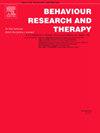Active positive searching versus passive negative avoidance: A comparative investigation of large-scale offline attention bias modification training in nonclinical adolescents
IF 4.5
2区 心理学
Q1 PSYCHOLOGY, CLINICAL
引用次数: 0
Abstract
Attentional bias (AB), characterized by a disproportionate allocation of attention toward threat-related stimuli, constitutes a well-established cognitive mechanism underlying anxiety disorders. As a targeted intervention, attentional bias modification (ABM) has garnered substantial empirical support for its efficacy in attenuating AB and ameliorating anxiety symptomatology. This study evaluated and compared the effectiveness of three major ABM training paradigms in reducing attentional bias manifestations: dot-probe task-based ABM (DPT-ABM), emotional spatial cueing task-based ABM (ESCT-ABM), and visual search task-based ABM (VST-ABM). Using the attention to negative inventory (ANI) scale, we screened 202 non-clinical adolescents exhibiting elevated levels of negative attentional bias (NAB) and randomly assigned them to either an active modification group (DPT-ABM, ESCT-ABM, or VST-ABM) or a matched control group (DPT-C, ESCT-C, or VST-C). Participants underwent eight offline training sessions across a four-week period. Attentional bias scores (ABS), learning anxiety, and sense of agency (SoA) were assessed at pre-test and post-test intervals. Additionally, a three-month follow-up evaluation was conducted to examine long-term changes in ABS. The results showed that VST-ABM led to significant and sustained reductions in ABS compared to its control group, while other paradigms did not produce such effects. This study provides new evidence that active search training for positive emotional stimuli in VST-ABM is more effective than passive avoidance training of negative stimuli in reducing negative attentional bias and improving emotional well-being in non-clinical adolescents.
主动积极搜索与被动消极回避:非临床青少年大规模离线注意偏差矫正训练的比较研究
注意偏倚(attention bias, AB)是焦虑障碍的认知机制,其特征是对威胁相关刺激的注意分配不成比例。注意偏倚矫正(attention bias modification,简称ABM)作为一种有针对性的干预手段,其在减轻注意偏倚和改善焦虑症状方面的有效性已经获得了大量的实证支持。本研究评估并比较了基于点探测任务的注意偏差训练范式(DPT-ABM)、基于情绪空间线索的注意偏差训练范式(ESCT-ABM)和基于视觉搜索任务的注意偏差训练范式(VST-ABM)在减少注意偏差表现方面的效果。使用注意负性清单(ANI)量表,我们筛选了202名表现出负性注意偏差(NAB)水平升高的非临床青少年,并将他们随机分配到积极修正组(DPT-ABM、ESCT-ABM或VST-ABM)或匹配的对照组(DPT-C、ESCT-C或VST-C)。参与者在四周的时间里接受了八次线下培训。注意偏差评分(ABS)、学习焦虑和代理感(SoA)分别在测试前和测试后进行评估。此外,进行了为期三个月的随访评估,以检查ABS的长期变化。结果表明,与对照组相比,VST-ABM导致ABS显著且持续的减少,而其他范式则没有产生这种效果。本研究提供了新的证据,证明VST-ABM中积极情绪刺激的主动搜索训练比消极情绪刺激的被动回避训练更能有效地减少非临床青少年的负性注意偏差和改善情绪幸福感。
本文章由计算机程序翻译,如有差异,请以英文原文为准。
求助全文
约1分钟内获得全文
求助全文
来源期刊

Behaviour Research and Therapy
PSYCHOLOGY, CLINICAL-
CiteScore
7.50
自引率
7.30%
发文量
148
期刊介绍:
The major focus of Behaviour Research and Therapy is an experimental psychopathology approach to understanding emotional and behavioral disorders and their prevention and treatment, using cognitive, behavioral, and psychophysiological (including neural) methods and models. This includes laboratory-based experimental studies with healthy, at risk and subclinical individuals that inform clinical application as well as studies with clinically severe samples. The following types of submissions are encouraged: theoretical reviews of mechanisms that contribute to psychopathology and that offer new treatment targets; tests of novel, mechanistically focused psychological interventions, especially ones that include theory-driven or experimentally-derived predictors, moderators and mediators; and innovations in dissemination and implementation of evidence-based practices into clinical practice in psychology and associated fields, especially those that target underlying mechanisms or focus on novel approaches to treatment delivery. In addition to traditional psychological disorders, the scope of the journal includes behavioural medicine (e.g., chronic pain). The journal will not consider manuscripts dealing primarily with measurement, psychometric analyses, and personality assessment.
 求助内容:
求助内容: 应助结果提醒方式:
应助结果提醒方式:


